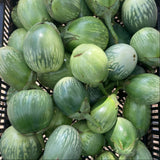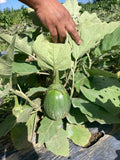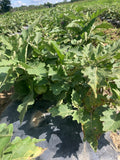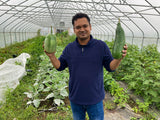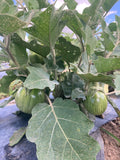Sobuz Bangun (Bangladeshi Green Eggplant)
Solanum melongena
This is a high producing and quick yielding eggplant variety, very popular in Bangladeshi and Indian communities. You can harvest up to 10 eggplants from a single plant during a growing season! This eggplant is round with a beautiful green colored skin, becoming a lighter green as it matures. The plant is bushy and compact, growing to 2 to 2.5 ft in height.
The flavor and texture is similar to a standard Italian eggplant. Bangladeshi Green Eggplant is versatile and pairs well with other vegetables, fish, and meat. Try it fried, grilled, boiled, or baked.
This seed was grown by Alam Ashraful, who been saving them for 5 years. Alam is an incubator farmer at Providence Farm Collective specializing in growing Bangladeshi vegetables, and is excited to sell his specialty Bangladeshi seeds to Truelove Seeds for the first time in 2025.
Days to maturity: 70
Seeds per pack: 45-50
Germination rate: 93% on 03/18/2025
Planting / harvesting notes
Sow seeds indoors 8-12 weeks before the last frost and transplant into the garden well after the danger of frost. 1/4 inch deep. Keep seedlings moist but do not overwater. Transplants should be initially watered in well, and plants will be most productive with regular irrigation and full sun.
Seed keeping notes
Eggplants are generally self-pollinating, though we isolate different varieties of the same species by 300 feet, in hopes that flying insects will not cross pollinate them unexpectedly. Eggplant seeds are ripe when the fruits get far past their edible stage, and have turned another color, in this case a duller, lighter purple. Cut the fruit, scrape out seeds (perhaps through a heavy-duty screen) into a vessel, add a little water (1-2 inches is probably plenty) to your seeds and pulp to keep them from drying out, and allow them to ferment away from direct sunlight. Fermentation is not necessary with eggplants, but it makes seed cleaning a bit easier. Ideally, you will stir the concoction every day for 3-5 days. In the end, add more water to fill the vessel, stir one final time, and allow to settle. Pour off the floating material and then strain the seeds through a strainer. Sometimes, you will need to add more water and pour off the floating material several times until the water is clear and you can see the seeds sunken at the bottom. Squeeze dry the strained seeds in a towel, and then lay out to dry on a labeled screen or paper product in a ventilated place away from direct sunlight for a week or two.






